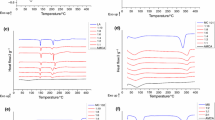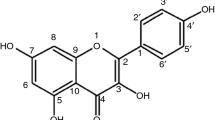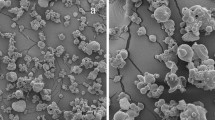Abstract
Compatibility studies comprise an important step in pre-formulation since they allow the identification of the excipients most compatible with herbal extracts from different analytical techniques. The objective of this work is to evaluate the compatibility between the nebulized extract of S. brasiliensis Engler with pharmaceutical excipients using analytical techniques associated with chemometric tools. The extract was nebulized through aspersion and produced from the hydroalcoholic extract of the bark of S. brasiliensis Engler. Binary mixtures were produced in various proportions using the following pharmaceutical excipients: starch, microcrystalline cellulose (Avicel® 101 and 102), lactose, magnesium stearate, PVP K-30 and talc. The samples were analyzed by optical microscopy, differential scanning calorimetry and X-ray diffraction (XRD). With the data obtained from DSC curves, matrices for hierarchical cluster analysis (HCA) and principal component analysis (PCA) were made. Using microscopy, an amorphous formation and/or crystalline components could be seen. In DSC curves, as well as in PCA and HCA analyses, possible interactions were identified with starch, lactose and magnesium stearate. This was confirmed by XRD. The starch showed the greatest interaction. The results indicate that the DSC technique associated with chemometric tools contributed to a better interpretation of compatibility studies and that microcrystalline cellulose, PVP K-30 and talc were the most compatible excipients in relation to the extract.






Similar content being viewed by others
References
Chaves TP, Dantas IC, Felismino DC, Vieira KVM, Clementino ELC, Costa LS. Atividade antimicrobiana das folhas de Schinopsis brasiliensis Engl. Biofar. 2011;5:11–7.
Saraiva AM, Castro RHA, Cordeiro RP, Peixoto-Sobrinho TJS, Castro VTNA, Amorim ELC, Xavier HS, Pisciottano MNC. In vitro evaluation of antioxidant, antimicrobial and toxicity properties of extracts of Schinopsis brasiliensis Engl. (Anacardiaceae). Afr J Pharm Pharmacol. 2011;5:1724–31.
Silva MSP, Brandão DO, Chaves TP, Formiga Filho ALN, Costa EMMB, Santos VL, Medeiros ACD. Study bioprospecting of medicinal plant extracts of the semiarid northeast: contribution to the control of oral microorganisms. Evid-Based Compl Alt. 2012;. doi:10.1155/2012/681207.
Cardoso MP, David JM, David JP. A new alkylphenol from Schinopsis brasiliensis Engl. Nat Prod Res. 2005;19:431–3.
Saraiva AM, Saraiva CL, Cordeiro RP, Soares RR, Xavier HR, Caetano N. Atividade antimicrobiana e sinérgica das frações das folhas de Schinopsis brasiliensis Engl. frente a clones multirresistentes de Staphylococcus aureus. Rev Bras Plantas Med. 2013;15:199–207.
Fernandes FHA, Santana CP, Santos RL, Correia LP, Conceição MM, Macêdo RO, Medeiros ACD. Thermal characterization of dried extract of medicinal plant by DSC and analytical techniques. J Therm Anal Calorim. 2013;113:443–7.
Gupta MM, Saini TR. Preformulation parameters characterization to design, development and formulation of vancomycin hydrochloride tablets for pseudomembranous colitis. Int J Pharm Res Dev. 2002;1:1–7.
Narang AS, Desai D, Badawy S. Impact of excipient interactions on solid dosage form stability. Pharm Res. 2012;29:2660–83.
Medeiros ACD, Cervantes NAB, Gomes APB, Macêdo RO. Thermal stability of prednisone drug and tablets. J Therm Anal Calorim. 2001;64:745–50.
Mura P, Furlanetto S, Cirri M, Maestrelli M, Marras AM, Pinzautti S. Optimization of glibenclamide tablet composition through the combined use of differential scanning calorimetry and d-optimal mixture experimental design. J Pharm Biomed Anal. 2005;37:65–71.
Tita B, Fulias A, Bandur G, Marian E, Tita D. Compatibility study between ketoprofen and pharmaceutical excipients used in solid dosage forms. J Pharm Biomed Anal. 2011;56:221–7.
Alves-Silva L, Sá-Barreto LCL. LIMA EM, Cunha-Filho MSS. Preformulation studies of itraconazole associated with benznidazole and pharmaceutical excipients. Thermochim Acta. 2014;575:29–33.
Detoisien T, Arnoux M, Taulelle P, Colson D, Klein JP, Veesler S. Thermal analysis: a further step in characterizing solid forms obtained by screening crystallization of an API. Int J Pharm. 2012;403:29–36.
Chadha R, Bhandari S. Drug-excipient compatibility screening—Role of thermoanalytical and spectroscopic techniques. J Pharm Biomed Anal. 2014;87:82–97.
Gallo L, Llabot JM, Allemandi D, Bucalá V, Piña J. Influence of spray-drying operating conditions on Rhamnus purshiana (Cáscara sagrada) extract powder physical properties. Powder Technol. 2011;208:205–14.
Medeiros ACD, Medeiros IA, Macêdo RO. Thermal studies of Albizia inopinata crude extract in the presence of cyclodextrin and Aerosil® by TG and DSC coupled to the photovisual system. Thermochim Acta. 2002;392–393:93–8.
Costa RS, Negrão CAB, Camelo SRP, Ribeiro-Costa RM, Barbosa WLR, Costa CEF, Silva Júnior JOS. Investigation of thermal behavior of Heliotropium indicum L. lyophilized extract by TG and DSC. J Therm Anal Calorim. 2015;111:1959–64.
Wesolowski M, Rojek B. Thermogravimetric detection of incompatibilities between atenolol and excipients using multivariate techniques. J Therm Anal Calorim. 2013;113:169–77.
Wesolowski M, Rojek B. Thermal decomposition and elemental composition of medicinal plant materials–leaves and flowers principal component analysis of the results. Thermochim Acta. 2003;397:171–80.
Melo CAD, Silva P, Gomes AA, Fernandes DD, Veras G, Medeiros ACD. Classification of tablets containing dipyrone, caffeine and orphenadrine by near infrared spectroscopy and chemometric tools. J Braz Chem Soc. 2015;24:991–7.
Rowe RC, Sheskey PJ, Quinn ME. Handbook of pharmaceutical excipients. 6th ed. Chicago: Apha; 2009.
Macedo RO, Do Nascimento TP, Veras JW. Compatibility and stability studies of propranolol hydrochloride binary mixtures and tablets for TG and DSC-photovisual. J Therm Anal Calorim. 2002;67:483–9.
Bazzo GC, Silva MAS. Estudo termoanalítico de comprimidos revestidos contendo captopril através de termogravimetria (TG) e calorimetria exploratória diferencial (DSC). Rev Bras Ciênc Farmac. 2005;41:319–22.
Tita B, Jurca T, Fulias A, Marian E, Tita B. Compatibility study of the acetylsalicylic acid with different solid dosage forms excipients. J Therm Anal Calorim. 2013;112:403–19.
Wesolowski M, Rojek B, Piotroska J. Application of chemometrically processed thermogravimetric data for identification of baclofen–excipient interactions. J AOAC Int. 2012;95:691–8.
Newman AW, Byrn SR. Solid-state analysis of the active pharmaceutical ingredient in drug products. Dr Discov Today. 2003;8:898–905.
Cano-Chauca M, Stringheta PC, Ramos AS, Cal-Vidal J. Effect of the carriers on the microstructure of mango powder obtained by spray drying and its functional characterization. Innov Food Sci Emerg Technol. 2005;6:420–8.
Gallo L, Piña J, Bucalá V, Allemandi D, Rámirez-Rigo MV. Development of a modified-release hydrophilic matrix system of a plant extract based on co-spray-dried powders. Powder Technol. 2013;241:252–62.
Acknowledgements
This study was supported by the Fapesq, Propesq/UEPB, Capes and CNPq (Process No.: 562957/2010-3). The authors especially thank Professor Ivan Coelho Dantas (in memoriam) for indicating the plant to be studied in this work.
Author information
Authors and Affiliations
Corresponding author
Rights and permissions
About this article
Cite this article
Fernandes, F.H.A., de Almeida, V.E., de Medeiros, F.D. et al. Evaluation of compatibility between Schinopsis brasiliensis Engler extract and pharmaceutical excipients using analytical techniques associated with chemometric tools. J Therm Anal Calorim 123, 2531–2542 (2016). https://doi.org/10.1007/s10973-016-5241-0
Received:
Accepted:
Published:
Issue Date:
DOI: https://doi.org/10.1007/s10973-016-5241-0




